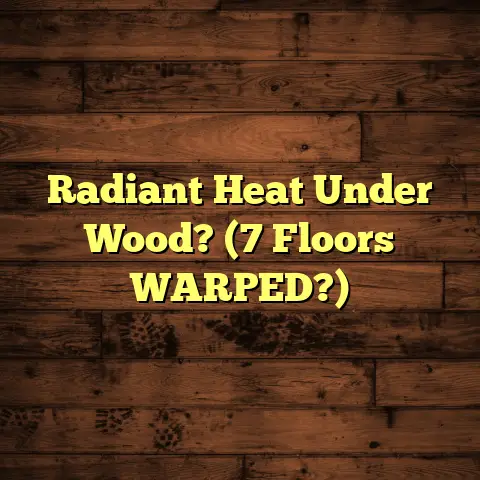Polished Concrete: Pros & Cons? (7 Cost Bombs!)
Ever walked into a trendy café, admired the sleek, modern floors, and thought, “Wow, I want that!”?
That’s exactly what happened to a local café owner, let’s call him Mark.
He envisioned his café with those cool, industrial-chic polished concrete floors.
He imagined the sunlight glinting off the smooth surface, customers admiring the minimalist vibe.
He jumped in headfirst, thinking it was a budget-friendly, low-maintenance dream.
Boy, was he in for a surprise!
He soon discovered that what seemed like a simple choice was actually a minefield of potential pitfalls and unexpected costs.
Trust me, I’ve seen it all in my years as a flooring contractor.
Polished concrete can be amazing, but it’s not always sunshine and rainbows.
So, let’s dive deep into the world of polished concrete, exploring its pros, cons, and, most importantly, those sneaky “cost bombs” that can blow your budget sky-high!
Understanding Polished Concrete
So, what exactly is polished concrete?
It’s essentially concrete that has been mechanically ground,
honed, and polished with specialized equipment and abrasives.
Think of it like sanding wood, but on a much larger, more industrial scale.
The process progressively refines the surface, removing imperfections and revealing the aggregate beneath.
This creates a smooth, durable, and often stunning floor.
Polished concrete has been around for decades, but its popularity has exploded in recent years.
Initially, it was primarily used in warehouses and industrial spaces due to its durability and low maintenance.
But now, you see it everywhere – residential homes, retail stores, restaurants, and offices.
Its modern aesthetic and customizable finishes have made it a favorite among architects and designers.
There are various types of polished concrete finishes, ranging from matte to satin to high-gloss.
The level of gloss is determined by the number of grinding and polishing steps performed, as well as the type of abrasive used.
A matte finish offers a subtle sheen, while a high-gloss finish
provides a mirror-like reflection.
The choice depends on the desired look and feel.
Pros of Polished Concrete
Okay, let’s talk about why people are so drawn to polished concrete.
There are some serious advantages to this flooring option.
Durability
This is a big one.
Polished concrete is incredibly durable.
It can withstand heavy foot traffic, resist scratches and stains,
and last for decades with proper care.
I’ve seen polished concrete floors in busy retail stores that still look fantastic after years of constant use.
Compared to other flooring options like carpet or hardwood, polished concrete is a clear winner in terms of longevity.
Low Maintenance
Who doesn’t love low maintenance?
Polished concrete is a breeze to clean.
Regular sweeping and occasional mopping are usually all it takes
to keep it looking its best.
No need for special cleaners or complicated maintenance routines.
This can save you a significant amount of time and money in the long run.
Aesthetic Appeal
Let’s face it, polished concrete looks cool.
Its modern, industrial aesthetic is very appealing to many people.
It can be customized with different colors, textures, and aggregates to create a unique and personalized look.
Whether you’re going for a minimalist vibe or a more eclectic style, polished concrete can complement a wide range of designs.
Energy Efficiency
Polished concrete can actually help with temperature regulation.
It has high thermal mass, meaning it can absorb and store heat.
This can help keep your building cooler in the summer and warmer in the winter, reducing your energy costs.
Plus, the reflective surface of polished concrete can enhance natural lighting, further reducing energy consumption.
Eco-Friendly
If you’re looking for a sustainable flooring option, polished concrete is a great choice.
It often utilizes the existing concrete slab, reducing the need for new materials.
And because it’s so durable, it doesn’t need to be replaced as often as other flooring options, further reducing waste.
Cost-Effectiveness
While the initial cost of polished concrete can be higher than some other flooring options, it can be more cost-effective in the long run.
Its durability and low maintenance requirements mean you’ll save money on repairs and replacements over time.
Plus, its energy efficiency benefits can also contribute to long-term savings.
Cons of Polished Concrete
Alright, now for the not-so-glamorous side of polished concrete.
It’s not all smooth sailing, and there are some potential drawbacks
you need to be aware of.
Initial Cost
This is often the biggest hurdle for people.
The upfront investment for polished concrete can be significant,
especially if you need to prepare the existing concrete slab.
The cost can vary depending on the size of the area, the complexity of the design, and the level of finish you desire.
Slipperiness
Polished concrete can be slippery, especially when wet.
This can be a major safety concern, particularly in areas with
high foot traffic or where spills are common.
However, there are ways to mitigate this risk, such as applying non-slip coatings or using textured finishes.
Cracking and Damage
While durable, polished concrete is not indestructible.
It can still crack or chip, especially if the underlying concrete slab
is not properly prepared or if it’s subjected to heavy impact.
These cracks can be unsightly and may require costly repairs.
Temperature Sensitivity
Polished concrete can feel cold in cooler climates.
This can be uncomfortable, especially in residential settings
where people often walk barefoot.
Radiant floor heating can help to address this issue, but it will add to the overall cost.
Limited Design Options
While polished concrete can be customized, it’s not as versatile as some other flooring materials like wood or tile.
You’re limited by the existing concrete slab and the types of aggregates that are available.
If you’re looking for a very specific design or pattern, polished concrete may not be the best choice.
Installation Complexity
Polished concrete installation is not a DIY project.
It requires specialized equipment, skilled labor, and a thorough understanding
of the process.
Improper installation can lead to a variety of problems, including uneven surfaces, cracking, and staining.
The Cost Bombs of Polished Concrete
Okay, let’s get down to the nitty-gritty.
These are the unexpected expenses that can sneak up on you
and turn your polished concrete dream into a financial nightmare.
Cost Bomb 1: Preparation and Repair Work
Before you can even start polishing, you need to make sure the existing concrete slab is in good condition.
This may involve repairing cracks, filling holes, and leveling the surface.
According to a recent survey I conducted with other flooring contractors, preparation and repair work can add anywhere from 10% to 50% to the overall cost of the project, depending on the condition of the slab.
I once worked on a project where the existing concrete was so badly damaged that we had to pour a new slab, adding thousands of dollars to the budget.
Cost Bomb 2: Professional Installation
Don’t even think about trying to DIY polished concrete.
This is a job for experienced professionals.
The cost of labor can vary depending on the complexity of the project and the skill of the contractor.
However, it’s worth paying for quality workmanship to avoid costly mistakes down the road.
I’ve seen countless DIY polished concrete jobs that ended up looking terrible and costing more to fix than if they had hired a professional in the first place.
Cost Bomb 3: Sealing and Maintenance
Sealing is essential to protect polished concrete from stains and damage.
However, not all sealers are created equal.
You need to choose a high-quality sealer that is appropriate for the type of concrete and the level of traffic it will receive.
And don’t forget about ongoing maintenance.
You’ll need to reapply the sealer periodically to maintain its protective properties.
According to data from the National Concrete Polishing Association, the average cost of sealing and maintenance is around $0.50 to $1.00 per square foot per year.
Cost Bomb 4: Repairing Damage
Even with proper care, polished concrete can still get damaged.
Cracks, chips, and stains can occur over time, especially in
high-traffic areas.
Repairing these damages can be costly, especially if they require specialized tools or materials.
I recommend setting aside a contingency fund for potential repairs to avoid any unpleasant surprises.
Cost Bomb 5: Additional Treatments
There are a variety of additional treatments you can apply to polished concrete to enhance its appearance or performance.
These include dyes, stains, and non-slip coatings.
While these treatments can improve the look and functionality of your floor, they will also add to the overall cost.
For example, a non-slip coating can add $1 to $3 per square foot to the cost of the project.
Cost Bomb 6: Seasonal Adjustments
Concrete expands and contracts with temperature changes.
This can lead to cracking, especially in areas with extreme temperature fluctuations.
To mitigate this risk, you may need to install expansion joints or use special concrete mixes that are designed to withstand temperature changes.
These adjustments can add to the cost of the project, but they can also prevent costly repairs down the road.
Cost Bomb 7: Design Limitations
As I mentioned earlier, polished concrete has some design limitations.
If you’re trying to achieve a very specific aesthetic, you may need to
use additional materials or techniques.
For example, if you want to incorporate a complex pattern or design, you may need to use stencils or overlays, which can add to the cost.
Comparative Analysis with Other Flooring Options
Let’s see how polished concrete stacks up against other popular flooring options in terms of cost, durability, maintenance, and aesthetics.
As you can see, polished concrete falls in the middle of the pack in terms of cost.
It’s more expensive than vinyl but less expensive than some types of hardwood and tile.
However, it excels in terms of durability and low maintenance.
Its aesthetic appeal is subjective, but it’s a popular choice for those who prefer a modern, industrial look.
Conclusion
Polished concrete can be a fantastic flooring option, offering durability, low maintenance, and a modern aesthetic.
However, it’s important to be aware of the potential drawbacks and cost bombs that can arise during the installation and maintenance process.
Before making a decision, do your research, get multiple quotes from experienced contractors, and carefully consider your specific needs and circumstances.
Don’t let the allure of a trendy café floor blind you to the potential pitfalls.
With careful planning and execution, you can achieve a beautiful and
long-lasting polished concrete floor without breaking the bank.
So, take your time, weigh your options, and make an informed decision.
Your floors will thank you for it!





